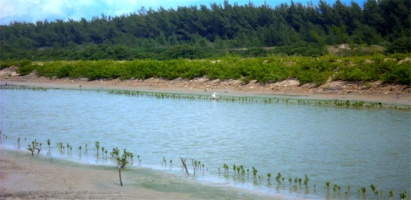
| February 18, 2014 | |
Environmental: Altamira, Long Beach
![]() Print this Article | Send to Colleague
Print this Article | Send to Colleague
The Port of Altamira is creating a 50.7-hectare/125-acre wetland area where it has already planted more than 30,000 mangrove trees of various species – red, black, white and button. The Port of Long Beach will fund testing of a new air pollution-control technology for docked cargo ships.
More than 30,000 Mangrove Trees Planted in Wetlands Created by the Port of Altamira
The Port of Altamira celebrated World Wetlands Day on February 2 and continued with its project of creating a 50.7-hectare/125-acre wetland area where it has already planted more than 30,000 mangrove trees of various species – red, black, white and button.
The project, according to the port, is the most extensive of its type in Mexico. The artificial wetland provides habitat for local and migratory birds, a sanctuary for mangroves found locally, nationally and internationally, and functions as a regulator of essential natural processes such as water and carbon cycles. It is also home for a great variety of terrestrial and aquatic wildlife such as red crabs, blue crabs, hermit crabs, snails and shrimp. The tree roots provide refuge from predators for small fish.
Additionally, notes the port authority, the wetlands absorb great quantities of water, reducing water levels during heavy rains and capturing contaminants harmful to humans such as heavy metals.
API de Altamira says the wetlands project reaffirms its commitment to the community and the environment and reinforces its image as a "sustainable port."

Wetland created by the Port of Altamira.
Photo/API de Altamira
Long Beach to Test New Clean-Air System for Ships
The Port of Long Beach will fund testing of a new air pollution-control technology for docked cargo ships, thanks to an agreement approved February 10 by the Long Beach Board of Harbor Commissioners.
Under the pact, the port would rely upon regional air quality authorities to oversee a demonstration project to thoroughly assess both the safety and the pollution-reducing effectiveness of a mobile, barge-mounted emissions control system to capture and treat ship smokestack emissions.
California recently began requiring container, refrigerated-cargo and cruise ships to plug in to shore power while at berth in order to reduce air pollution by using landside electricity. However, the shore power regulations only apply to about 100 of the port's 300 vessel calls a month.
The new system could provide an alternative to shore power, allowing ships to run their engines to produce the power they need for lighting, communications, pumps, refrigeration and the like. The Alternative Maritime Emission Control System, or AMECS, diverts a docked ship’s emissions into an air-pollution filter-and-treatment device.
A Los Angeles-area-based company developed the AMECS technology. Under the agreement, the South Coast Air Quality Management District will supervise the testing under port staff oversight.
The Clean Air Action Plan approved by the ports of Long Beach and Los Angeles set a goal to find alternative technology to reduce air pollution from ships at berth, for ships not covered by the state’s shore power regulation.
The Port of Long Beach has been working with the company since 2006 on demonstrating the technology. An earlier, wharf-mounted version was often called "sock on a stack" due to the large bonnet that was lifted by crane and placed over the smokestacks to capture emissions (Advisory, June 16, 2006). The new system is mounted on a barge and uses a direct connection to a vessel’s exhaust outlets.
The AMECS demonstration project is contingent upon full execution of a contract and agreement among the parties. The port will fund the total project cost of $2,063,624. Harbor Commission approval of the project's budget was granted in July 2013.
